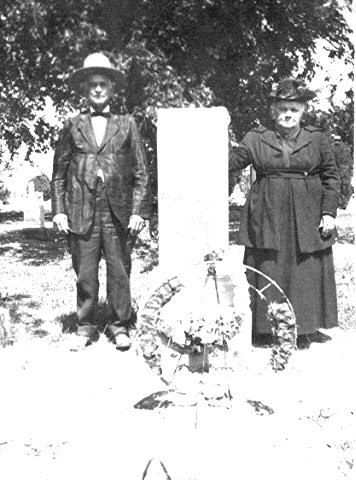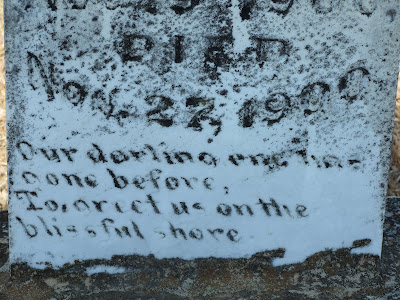I stumbled upon
McBryde Cemetery by accident a couple of weeks ago.
The original purpose of my after-work expedition was to fulfill a couple of photo requests at
Sharp Cemetery for someone on
Find-A-Grave.
Sharp Cemetery is a short drive out of town, though it felt longer with the hundred-plus degree temperature and the air conditioner in my car enthusiastically blowing warm air at me the entire way.
Almost to my turn, I passed the brown Historical Marker sign pointing to
McBryde Cemetery. As with pretty much every Historical Marker sign I pass (unless I actually have time to stop), I made a mental note of it as a possible stop for a later trip. Incidentally, it's sort of interesting how many of those signs in Texas are for cemeteries; it would be interesting to find out how other places' Historical Marker ratios compare.
I started intrepidly down Sharp Cemetery Road despite the yellow sign proclaiming it a dead end (clever, no?), and drove for a long while down a tree-shaded dirt road lined by a crumbling stone wall of loose construction and indeterminate age, but came up short at the second cattleguard flanked by a firm-sounding POSTED: No Trespassing sign, just in the shadow of someone's house. Unwilling to risk getting shot, or even shot at, I declared discretion the better part of valor and sadly turned around.
As I turned off Sharp Cemetery Road and back onto the highway, I suddenly remembered how close
McBryde Cemetery had been and decided, on a whim, to stop and check it out. I had no idea whether there were any photo requests open for
McBryde Cemetery, or whether there was anything left to contribute to the site's record on
Find-A-Grave, but it seemed worth a try. Besides, I was unwilling to let go of my afternoon outing, and I decided it would make good photography practice even if I got no other results. I had come all this way in my poorly-air-conditioned car to photograph gravestones, after all.
McBryde Cemetery is set on a lonely-feeling patch of land just off the highway, sparsely shaded by just a few small trees. It feels very open and on the day I visited was very bright and hot, archetypal central Texas ranchland.

It contains thirteen interments, six couples and one individual, all members of the intermarried McBryde and Hoover families.
Genealogically and culturally, the cemetery is interesting because it contains multiple generations of a single lineage. In terms of my personal interest in mortuary iconography, my attention was mostly captured by the oldest four interments, two pairs of heavily weathered markers facing west set in the stone walls enclosing two pairs of burial plots.

It is interesting to note that although members of these couples opted for individual burials- not only with individual graves and markers, but with the graves clearly delineated by roughly chest-high stone walls- rather than double interments and double markers (the choice of most of their descendants interred here), each pair of grave markers shares a common design, so that it is readily apparently from the images on the gravestones which person belonged with which in life.
McBryde Cemetery's first occupant,
Jane W. (Gore) McBryde (1826-1885) shares a resting lamb image with her husband
Mancel Theodore "M.T." McBryde (1821-1896).
 Jane W.
Jane W.Wife of
M.T. McBryde
Born
June 14, 1826,
Died
Aug. 31, 1885.
God gave. He [unreadable]. He will
restore. He doeth all things
well.
 M.T. McBrydeBornjuly 17, 1821.DiedNov. 2, 1885.Blessed is he thatconsidereth the Poor.The Lord will consider him.
M.T. McBrydeBornjuly 17, 1821.DiedNov. 2, 1885.Blessed is he thatconsidereth the Poor.The Lord will consider him.The couple died over a decade apart; note the differences in the individual artwork of the lambs; it is possible that either the gravestones were not the work of the same manufacturer, or the style changed in the intervening years.


It seems unusual to see the lamb imagery used for adult gravestones, since the sources I have read usually attribute the lamb to the symbolism of children and their innocence. I have seen lambs on several other adults' gravestones in this area, though, and just as commonly I have seen doves on children's gravestones, though they too appear on adult gravestones. Part of the goal of my cemetery wandering for the forseeable future will be collecting data to assess whether there is an observable correlation between symbolism and age at death in nineteenth-century Texas gravestone iconography.
Interred at the elder McBryde's right are his son
Robert H. McBryde (1860-1887) who was apparently
born in the same year his grandfather- whose name he shares- died, and Robert's wife
Nancy Paralee (Story) McBryde (1867-1951).

The younger pair of McBrydes share a clasped-hands motif. Like the lambs on the older two gravestones, these two are markedly different in style over the sixty-four year gap between them.
 Paralee Story
Paralee Story
McBryde
Wife ofR.H. McBryde
Born
Oct. 15, 1867
Died
May 6, 1951
At rest in heaven.
Robert McBryde's gravestone is substantially less weathered than his wife's despite being the older of the two.
 Robert H. McBryde
Robert H. McBryde
Born
Nov. 2, 1860,
Died
Oct. 7, 1887.
The Lord giveth and the Lord
hath taken away. Blessed be
the name of the Lord.The two images do share obvious gender differences in the sleeves on either hand, particularly Robert McBryde's; some gender cues are even obvious in the relative size of the fingers on the clasping hands.

This was my first cemetery outing without my husband and his photography skills, which meant it was my first attempt at gravestone photography. Despite some mostly theoretical training in crime scene photography (although we're required to know the rudiments in theory, the dog team seldom actually gets called on to take pictures on-scene), most of my prior photography experience was in the artifact lab under very controlled lighting conditions. The heavily slanted late evening sunlight cast long shadows and slightly awkward glare, which presented a real challenge. My own shadow unfortunately ended up in most of the east-facing photos; in retrospect, this could have been prevented if I had figured out sooner how to operate the zoom on my husband's camera.

Thanks to a very high-resolution camera and a bit of careful cropping, I still ended up with acceptable pictures of most of the gravestones.
It turned out that there were no photo requests for
McBryde Cemetery, but the trip was still an enjoyable and interesting experience, and I came away with some nice photographs and a couple of gravestone photography lessons:
1. The zoom lens is a good way to keep your own shadow out of the images.
2. Time of day is important, otherwise shadows and glare get in the way.
As a side note, I learned the next day that cemeteries located on private property in the state of Texas are legally accessible by anyone for reasonable purposes during reasonable hours, and the landowner is legally obligated to allow right-of-way for such access.
I have since made several
pleasant and productive visits to Sharp Cemetery.





















































